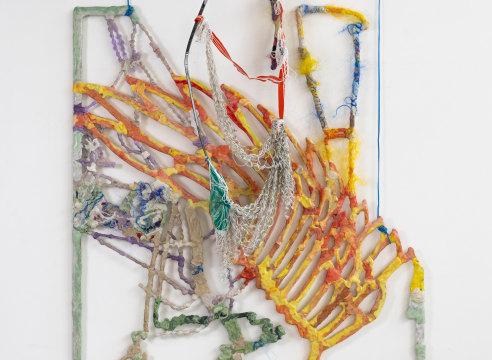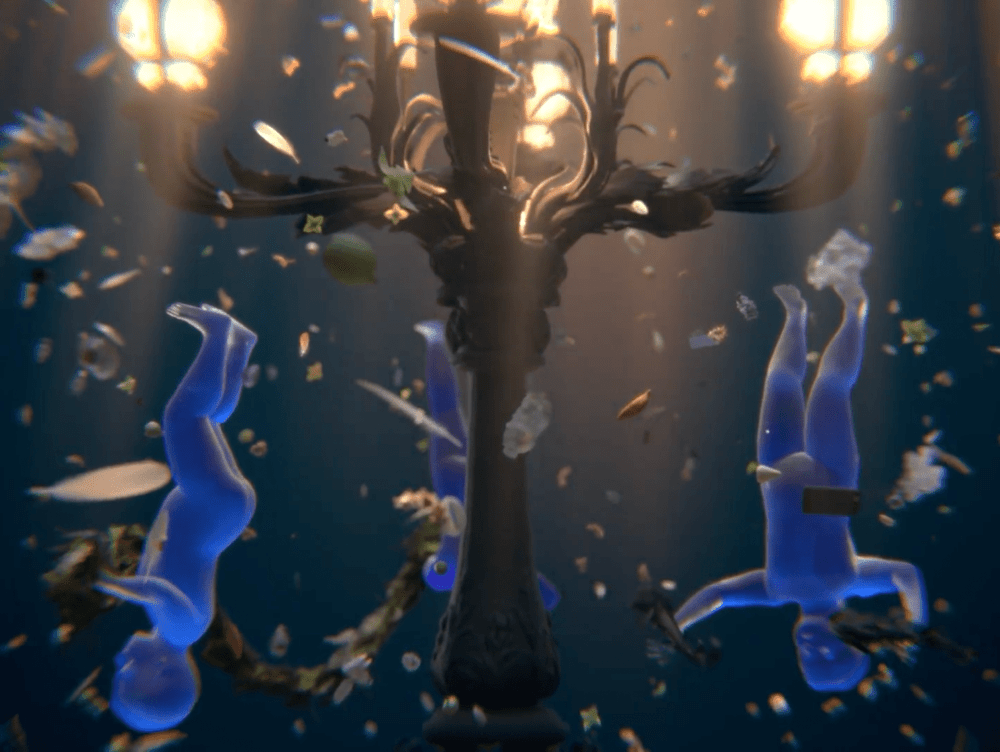

Julien Creuzet (b. 1986, Le Blanc Mesnil, France, lives Paris) has reimagined his French Pavillion from the 60th Venice Biennale for The Bell. An immersive video and archipelagic sculptural installation, Attila cataract your source at the feet of the green peaks will end up in the great sea blue abyss we drowned in the tidal tears of the moon (2024) extends Creuzet’s focus on water as a site of both historical and contemporary traumas and emancipatory futures. A liquid ecosystem of voice, texture, sound, and moving image as divine presence, this multisensorial project is deeply sonic and draws from hip-hop, jazz, and other musical forms and bodily gestures across the African diaspora. Creuzet’s artistic practice has long referenced legacies of colonialism, and his challenge to the architecture and history of the French Pavilion extends to Brown University's campus and Providence’s centrality within the Black Atlantic.
Brown is situated near the Providence River, one of the many Rhode Island ports through which the largest number of enslaved Africans entered the Thirteen Colonies prior to 1774. Triangulated with Africa and the Caribbean in the 18th century, the shipping industry of Rhode Island evolved to be deeply enmeshed with the U.S. cotton industry as the region became a center of textile production in the 19th century. Creuzet is fascinated by the watery connection between Venice, the Caribbean island of Martinique where his family has lived for generations, and Providence, conceptualizing the migration of the pavilion across a Mediterranean Sea and Atlantic Ocean dense with histories that have long informed his work. The presentation at Brown is of a different viscosity, an adaptation to Providence waterways and colonial thematics that are present on campus and loom large across the region.
At Brown, Creuzet expands his sculptural practice while introducing new forms of environmental affect. Six massive steel floor sculptures commissioned for The Bell are installed across the List Lobby and into the gallery, mercurial amalgams of tropical foliage and animals silhouetted and superimposed onto islands of layered meaning and metaphor. Shimmering under the light of four massive projection screens, these metal objects create an aquatic visual presence that forces contact with a ground material separate from the tile and painted cement floors of the galleries. To enter into the List Art Building and The Bell, one must walk across and through these sculptures, which shift slightly based on angle and approach. The installation insists on a tactile relationship with viewers, one that is echoed in the music that emanates from The Bell and List Lobby and flows into the interstitial social spaces of the building.
The translinguistic soundscape of Attila cataract (...) is a dirge to those who have experienced death in the Black Atlantic, both forced upon by others and through forms of self-emancipation. These six songs feature lyrics written by Creuzet—predominantly in creolized French with real-time translation in Portuguese, English, and Spanish available on a large flatscreen—reflecting the migratory and cultural entanglement of the Caribbean in defiance of colonial borders and nation-states. Sonically overflowing at and beyond the liminal space of the gallery, they were composed to accompany the four-channel video installation to form the core conceptual elements of the project as it travels beyond Venice. Video animations feature sea creatures both real and mythic, from turtles and fish to languid oceanic deities: a sinking Neptune statue from the staircase of the Doge’s Palace in Venice; three cherubs dancing around the Art Nouveau streetlight from Pont Alexandre III bridge in Paris; and mermaid figures that reflect African cosmologies away from the hyper-sexualized fantasies of European sailors. The gestures these various figures perform are drawn from Creuzet’s Afro-diasporic archive of dance and rituals, a global gathering of movement that has recently propelled his practice into the choreographic.
Opening Attila cataract (...) on February 20th is the performance Algorithm ocean true blood moves (2023), a collaboration between Creuzet and Brazilian choreographer Ana Pi. Co-commissioned by Performa and the Hartwig Art Foundation, Amsterdam and mounted on the main stage of Brown’s new Lindemann Performing Arts Center, Algorithm ocean true blood moves features vocalist Malou Beauvoir, bélé drummer Boris Percus, and the Martinican dancehall genre Shatta composed by musician Natoxie with dancers from The Ailey School trained in the Caribbean and Africanist dance techniques that undergird Alvin Ailey’s aesthetic. During Algorithm ocean true blood moves the dancers engage with long pole sculptures that are knotted and fringed with the fibrous vocabulary of Creuzet’s sculptural practice. Structuring shapes are wrapped in multiple layers of string, rope, and twine that incorporate found objects into their design and leave tendrils to drape towards the ground, often directly engaging with his metal floor pieces.
Following the performance of Algorithm ocean true blood moves, the poles will be installed within The Bell for the remainder of the exhibition, a material afterlife rich with the potential kinetic energy that informs so much of Creuzet’s static objects. Joined by two additional vertically aligned sculptures, they collectively appear uprooted in the gallery, mounted in air and capable of growth in any direction. In longtime connection with Martinican poet and philosopher Édouard Glissant, Creuzet’s practice embodies the “relational poetics” that Glissant theorized as rhizomatic, defining French-Caribbean identity as both evolving and contextualized by the complex global histories that shaped French and European modernity projects worldwide, including slavery in the United States. As the project coheres on this side of the Atlantic, Attila cataract (...) unfolds in a resonance of loss and resistance, an act of reparation/emancipation/reclaiming and celebration of Afro-diasporic systems of knowledge, beliefs, and philosophies.
– Kate Kraczon, Chief Curator and Director of Exhibitions, The Bell / Brown Arts Institute